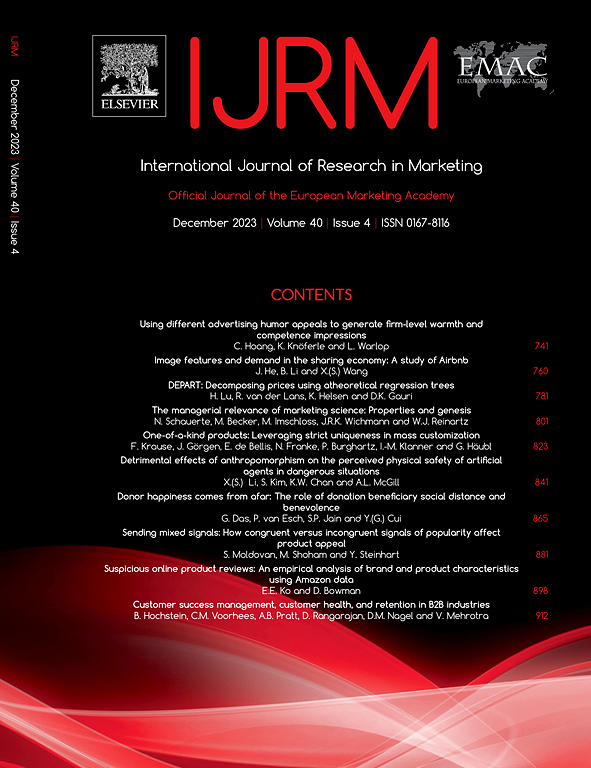表情符号营销:迈向品牌副语言学理论
IF 7.5
2区 管理学
Q1 BUSINESS
International Journal of Research in Marketing
Pub Date : 2025-03-01
DOI:10.1016/j.ijresmar.2024.06.002
引用次数: 0
摘要
表情符号,或补充或取代书面语言的象形文字,在当代交流中无处不在,包括表情符号营销。根据语言学和符号理论的见解,目前的研究提出了一个表情符号营销框架,其中表情符号的象征意义(符号与符号的使用)影响消费者的信息评价(感知到的信息亲密度和清晰度),进而影响品牌文化相关性(命题P1和P2)。表情符号语法(即表情符号是否补充文字)和营销-消费者群体相关性(共享与非共享组成员)调节表情符号符号与消费者信息评价之间的关系。该框架表明,使用表情符号作为符号的信息,相对于没有表情符号(纯文本)的营销信息,如果这些表情符号补充了文本,则会唤起更大的感知信息清晰度(P3a)和更大的感知信息亲密度(P4a),如果共享群体关系,则会产生更大的亲密度(P5a)。相比之下,如果消息使用表情符号作为图标,同样相对于没有表情符号(纯文本)的营销消息,如果表情符号没有补充文字(P3b),它们会产生更高的感知信息清晰度(P4b和P5b),无论营销人员与消费者群体的关系如何,它们都会产生更高的感知信息清晰度和亲切感(P4b和P5b)。作者提出了几个影响和相关的研究途径,可以利用这个新颖的表情符号营销框架。本文章由计算机程序翻译,如有差异,请以英文原文为准。
Emoji marketing: Toward a theory of brand paralinguistics
Emojis, or pictographs that supplement or replace written language, have become ubiquitous in contemporary communication, including emoji marketing. Drawing on insights from linguistics and sign theory, the current research proposes an emoji marketing framework in which emoji symbolism (symbolic vs. iconic emoji use) affects consumers’ message appraisals (perceived message intimacy and clarity), which in turn influence brand cultural relevance (propositions P1 and P2). Emoji syntax (i.e., whether emojis are supplemented with text or not) and marketer-consumer group relatedness (shared vs. unshared group membership) moderate the relationship between emoji symbolism and consumers’ message appraisals. The framework suggests that messages that use emojis as symbols, relative to no-emoji (text-only) marketing messages, evoke greater perceived message clarity (P3a) and greater perceived message intimacy (P4a) if those emojis are supplemented with text, as well as greater intimacy if group relatedness is shared (P5a). In contrast, if messages use emojis as icons, again relative to no-emoji (text-only) marketing messages, they produce greater perceived message clarity if emojis are not supplemented with text (P3b) and higher perceived message clarity and intimacy regardless of marketer-consumer group relatedness (P4b and P5b). The authors present several implications and pertinent avenues for research that can leverage this novel emoji marketing framework.
求助全文
通过发布文献求助,成功后即可免费获取论文全文。
去求助
来源期刊
CiteScore
11.80
自引率
4.30%
发文量
77
审稿时长
66 days
期刊介绍:
The International Journal of Research in Marketing is an international, double-blind peer-reviewed journal for marketing academics and practitioners. Building on a great tradition of global marketing scholarship, IJRM aims to contribute substantially to the field of marketing research by providing a high-quality medium for the dissemination of new marketing knowledge and methods. Among IJRM targeted audience are marketing scholars, practitioners (e.g., marketing research and consulting professionals) and other interested groups and individuals.

 求助内容:
求助内容: 应助结果提醒方式:
应助结果提醒方式:


